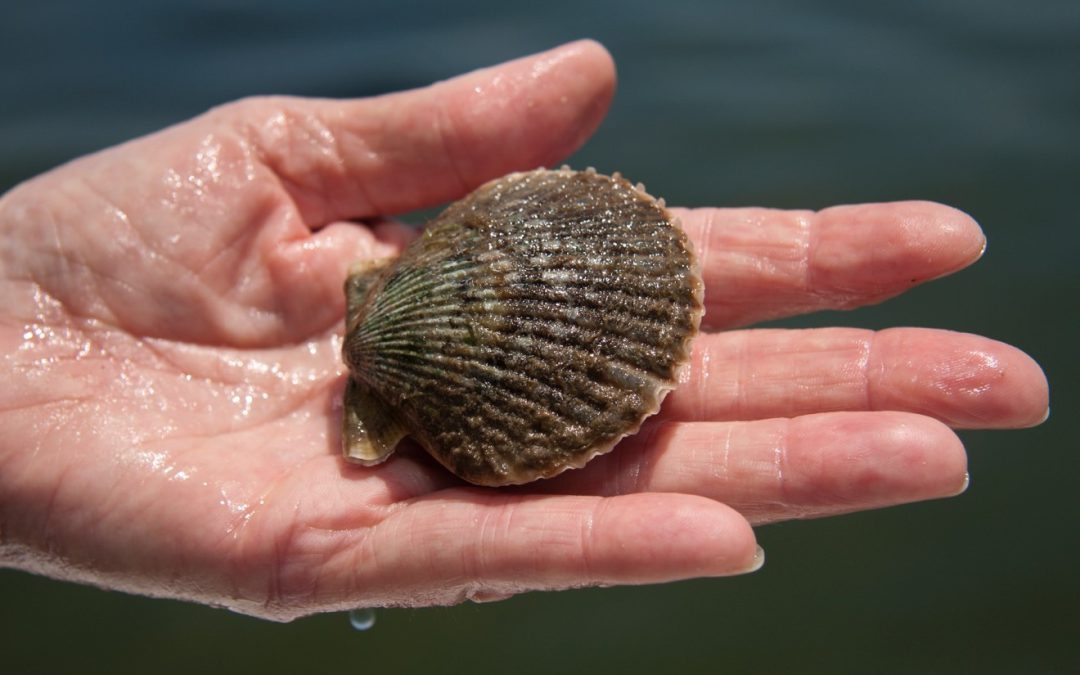
by Ray Bodrey | Apr 20, 2021

Scott Jackson, UF/IFAS Extension Bay County & Florida Sea Grant
Ray Bodrey, UF/IFAS Extension Gulf County & Florida Sea Grant
Erik Lovestrand, UF/IFAS Extension Franklin County & Florida Sea Grant
Can you remember where you were one year ago last April? The uncertainty of each day seemed to go on forever. At this time last year, we were planning several education programs that eventually had to be canceled or migrated to online events. Scallop Sitters was one of our cooperative volunteer programs with Florida Fish and Wildlife (FWC) that was postponed during the pandemic in 2020. Thankfully, FWC biologists continued restoration work last year in the region with good results and steps forward. However, there was something painfully absent in these efforts – you!
One of the lessons last year taught us, is to appreciate our opportunities – whether it is to be with your family, friends, or serve your community freely through volunteer service. Some new service opportunities appeared while others were placed on hold. Thankfully, we are excited to announce the Scallop Sitters Citizen Scientist Restoration Program is returning to our area in St. Andrew, St. Joe, and Apalachicola Bays this summer!
Historically, populations of bay scallops were in large numbers and able to support fisheries across many North Florida bays, including St Andrew Bay. Consecutive years of poor environmental conditions, habitat loss, and general “bad luck” resulted in poor annual scallop production and caused the scallop fishery to close. Bay scallops are a short-lived species growing from babies to spawning adults and dying in about a year. Populations can recover quickly when growing conditions are good and can be decimated when conditions are bad.
An opportunity to jump start restoration of North Florida’s bay scallops came in 2011. Using funding as a result of the Deepwater Horizon Oil Spill, a multi-county scallop restoration program was proposed and eventually established in 2016. Scientists with FWC use hatchery reared scallops obtained from parents or broodstock from local bays to grow them in mass to help increase the number of spawning adults near critical seagrass habitat.
FWC also created another program where volunteers can help with restoration called “Scallop Sitters” in 2018 and invited UF/IFAS Extension to help manage the volunteer portion of the program in 2019 which led to targeted efforts in Gulf and Bay Counties.
After a year’s hiatus, UF/IFAS Extension is partnering with FWC again in Bay and Gulf Counties and expanding the program into Franklin County. Despite initial challenges with rainfall, stormwater runoff, and low salinity, our Scallop Sitter volunteers have provided valuable information to researchers and restoration efforts, especially in these beginning years of the program.
Volunteers manage predator exclusion cages of scallops, which are either placed in the bay or by a dock. The cages provide a safe environment for the scallops to live and reproduce, and in turn repopulate the bays. Volunteers make monthly visits from June until January to their assigned cages where they clean scallops removing attached barnacles and other potential problem organisms. Scallop Sitters monitor the mortality rate and collect salinity data which determines restoration goals and success in targeted areas.
You are invited! Become a Scallop Sitter
1.Register on Eventbrite
2.Take the Pre-Survey (link will be sent to your email address upon Eventbrite Registration)
3.View a Virtual Workshop in May
4.Attend a Zoom virtual Q & A session in May or June with multiple dates / times available
5.Pick up supplies & scallops on June 17 with an alternate pick-up date to be announced
UF/IFAS Extension is an Equal Opportunity Institution.
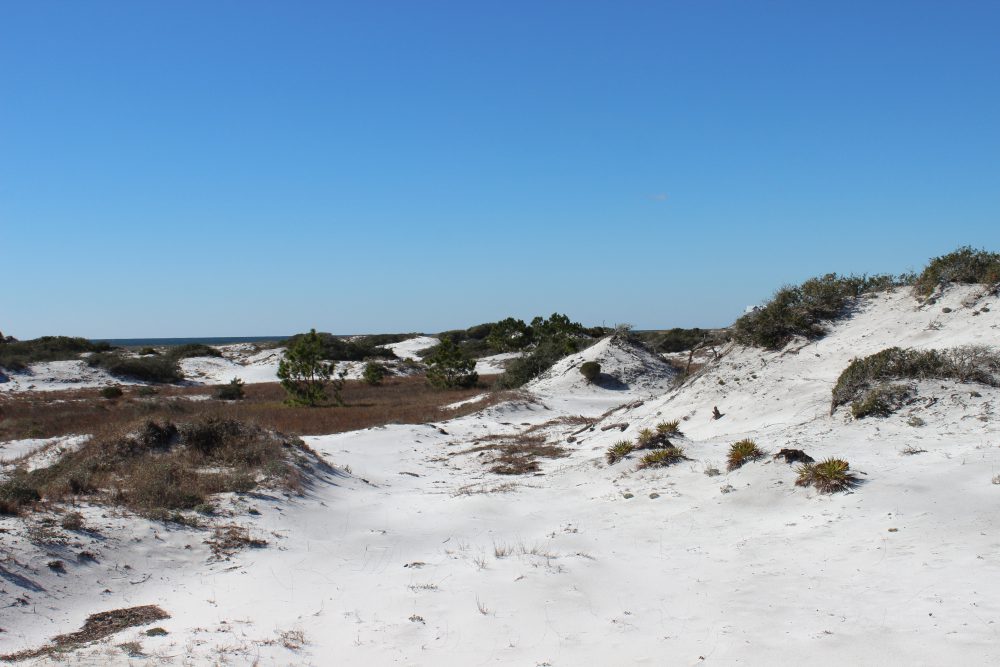
by Rick O'Connor | Dec 3, 2020
Along the northern Gulf coast is a string of long-thin sand bar islands we call barrier islands. They are called this because they serve as a barrier to the mainland from open water storms. These long sandy islands are very dynamic and constantly shift and move with the tides, currents, and waves. They can shift as far as 300 feet after a strong hurricane.

The white quartz sand beaches of the barrier island in the northern Gulf of Mexico.
Photo: Molly O’Connor
Life on these islands can be very tough. In addition to the constantly moving sand, there is salt spray in the wind, intense sunlight much of the year, high winds at times, and little rainfall to provide freshwater. Even though our area can receive as much as 60 inches of rain a year, much of this falls in the northern end of the counties, and not on the beaches. That said, there are freshwater ponds on some the islands and even larger dune lakes in Walton County – there life is not as hard.
As you cross a barrier island from the Gulf to the bay, you will cross distinct environmental zones. These zones are defined by the abiotic factors wind and salt spray and are named by their dominant plant forms having distinct animal life associated with them.
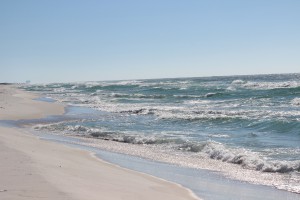
The beach zone seems life-less but it is not. Look beneath the sand.
Photo: Molly O’Connor
The beach is barren. This is the section of sand that extends from the water line of the Gulf to the first line of dunes. Few, if any plants can grow here. The high wave energy will not allow plants to grow along the shoreline, nor in the water itself. The wind and salt spray are high and the sand ever changing. All of the animal life here lives beneath the sand. They emerge when the wind and waves have slowed and scavenge on what they can find for food. Their primary production comes from the decomposition of the strands of seagrass and seaweed that line the shore – what we call wrack. Many will filter phytoplankton from the water as the waves wash in and seabirds are constant predators. When conditions get a little too much, they migrate a little offshore in deeper water to wait it out. But here fish and larger invertebrates become predators – so, they may not stay long.
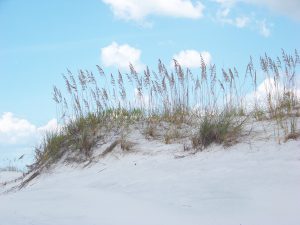
The primary dune is dominated by salt tolerant grasses like this sea oat.
Inland of the beach is the first dune line – the primary dune. This dune field is dominated by grasses because woody plants cannot tolerate the high wind. Most of these herbaceous plants have fibrous root systems that trap blowing sand and form dunes. The dominant grasses found here would include panic grass, beach elder, and the sea oat. The seeds of these plants provide food for creatures like the beach mice and some birds. Ghost crab burrows are often found here seeking shelter from the high energy environment of the beach. And, as you would expect, predators visit. Snakes, coyotes, and fox seeking the small mice.
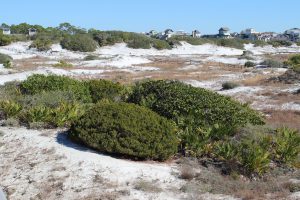
Small round shrubs and brown grasses within the swales are characteristic of the secondary dune field.
Photo: Rick O’Connor
This primary dune line blocks some of the wind and salt spray from the Gulf and allows small woody shrubs to grow. These shrubs will form a secondary dune system, which may grow slightly higher than the primary dunes. Shrubs like seaside rosemary, goldenrod, and false rosemary can be found here and give the dunes color when they are in bloom. The grasses found in the primary dune can also be found here. Beach mice and ghost crabs can work their way to this environment but because the wind is blocked by the primary dune other animals can be found here including: armadillos, opossum, a variety of snakes, and maybe even a gopher tortoise. Within the secondary dune field there are low areas that, at times, fill with rainwater. These are called swales and have their own unique wildlife. Grasses like broomsedge, needlerush, and bull rush can be found here. Along the edge you may find carnivorous plants such as the sundew. Freshwater attracts all wildlife, but the tenants could include a variety of amphibians, reptiles, and even some hardy species of fish.
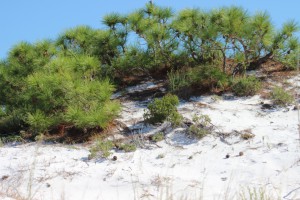
The top of a pine tree within a tertiary dune.
Photo: Molly O’Connor
On the back side of the island are some of the largest dunes. These are held in place by salt tolerant trees such as live oak, pine, and even magnolia. However, these trees look different than the ones that grow in our yards. They are the same species, but their growth seems stunted and often they look like the wind has blown their growth northward. This is known as wind sculpting and all of it is caused by the salt spray coming from the Gulf. These trees form a maritime forest where a variety of wildlife species do well. Deer, armadillo, opossum, skunks, coyote, fox, raccoon, hawks, owls, eagles, all sorts of snakes and woodland birds can be found here. In these xeric conditions, it is not uncommon to find a lot of cactus. Most of these creatures are hiding during the day, but at sunset they begin to move.
During these colder winter months, we encourage you to explore these beach habitats.
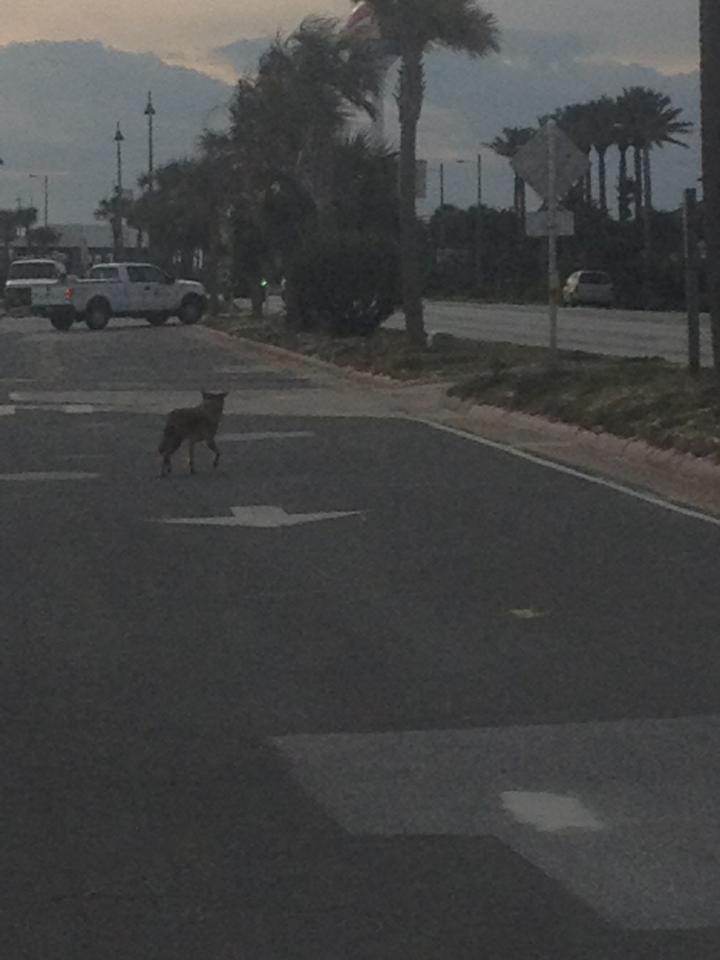
by Rick O'Connor | Oct 21, 2020
It’s Halloween…
The time of year we think of werewolves, warlocks, witches, and full moon evenings. But there is another creature who likes to howl at the moon this time of year – the coyote.
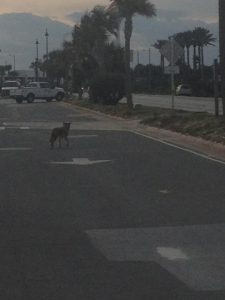
A coyote moving on Pensacola Beach near dawn.
Photo provided by Shelley Johnson.
Actually, coyotes howl all throughout the year, and they are not specifically howling at the moon. The name “coyote” is a Native American term meaning “singing dog”, or “barking dog”. They are famous for their early evening and early morning calls. Howls, barks, yelps, and yaps are very familiar to those living out west – and now for those living in the eastern United States.
It is believed the animal originated in the grasslands and deserts of the American southwest feeding on a variety of rodents. They have successfully dispersed across the country and can now be found in almost any habitat in the continental United States – including barrier islands. Though they owe much of their success to their ability to adapt to different foods and habitats, they also owe some of their success to humans. We have reduced their primary predators – bears, wolves, and mountain lions – to a level where they could move around more safely. There have been efforts to restore these predator populations in some localized areas of the U.S., but those are localized, and the process has been slow. All the while the coyote has enjoyed a more predator free world.
They are also opportunistic feeders. Though the bulk of their diet are small rodents, they are known to eat small birds, reptiles, amphibians, rabbits, squirrels, and even fruit. Out west, working in teams, they can take down larger prey – such as deer, and can do so here in the east as well. But their large prey targets are usually smaller members of the herd, sick, or old ones. They have also learned to feed on road kills of these animals.
Then there are humans. We provide an abundance of garbage which they have learned to scavenge through. Pet food left outside, gardens with produce, small livestock, and even pet cats and small dogs have been added to their menu. We have made their world much better.
With their numbers increasing in human populated areas, like Santa Rosa Island, people are becoming a bit nervous around them. The image of the toothed predator howling at the harvest moon on Halloween night in a pack with others makes us a bit uneasy. So, how dangerous are they?
Not very.
Coyotes are intelligent animals, and though they have learned to live and hunt within our neighborhoods, they are still afraid of us – they consider us trouble. On a recent trip to Colorado I was hiking down a trail and saw what appeared to be two sets of pointed ears in the grass. My guess was coyote but was not sure – so I began to walk towards them. Three coyotes immediately got up and moved off across the next ridge. They wanted nothing to do with me. And that is how it should be.
Those on barrier islands, like Santa Rosa, are no different. They are more active at dawn and dusk (crepuscular) and spend their days and late nights in a den somewhere. Occasionally people will see them in the middle of the day, or hear a yelp or howl around 2:00 AM, but it is more of a sunrise and sunset deal for them. They can remain motionless and undetected when people are around and will often run if we get too close. Many are not sure whether they are seeing a coyote or a German shepherd when they see one, both being about the same size. Coyotes tend to run with their tails down, unlike dogs and wolves who prefer to run with their tails up.
All of this said, there have been attacks on people – mostly out west and in southern California in particular. In most cases, the animals have either intentionally or unintentionally been fed by people. When this happens, they lose their fear of us and return for another easy meal. They are wild animals and being cornered by people or dogs (intentionally or unintentionally) can lead to defensive behaviors that could include attacks. To avoid this, we should not approach any coyote. Keep your trash secured and in cans that would be difficult for coyotes to access. Bring your pet food in at night and do not let pet cats and small dogs out in the evenings without supervision.
Bad encounters with these howling animals are rare, and with a little education and behavior changes on our part, should remain so.
Happy Halloween.
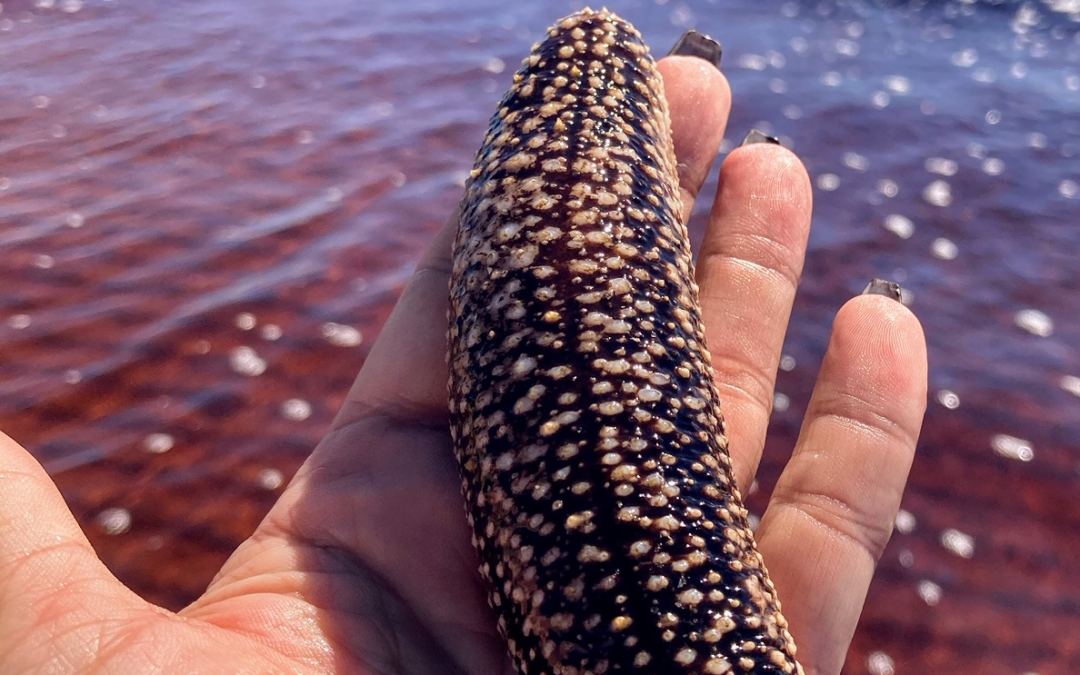
by Sheila Dunning | Oct 16, 2020
That’s the question from a recent group exploring what washed up on the beach after Hurricane Sally.
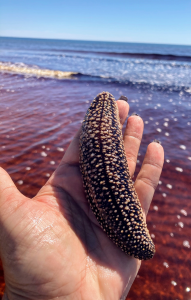
Sea Cucumber
Photo by: Amy Leath
They have no eyes, nose or antenna. Yet, they move with tiny little legs and have openings on each end. Though scientists refer to them as sea cucumbers, they are obviously animals. Sea cucumbers get their name because of their overall body shape, but they are not vegetables.
There are over 1,200 species of sea cucumbers, ranging in size from ¾“ to more than 6‘ long, living throughout the world’s ocean bottoms. They are part of a larger animal group called echinoderms, which includes starfish, urchins and sand dollars. Echinoderms have five identical parts to their bodies. In the case of sea cucumber, they have 5 elongated body segments separated by tiny bones running from the tube feet at the mouth to the opening of the anus. These squishy invertebrates spend their entire life scavenging off the seafloor. Those tiny legs are actually tube feet that surround their mouth, directing algae, aquatic invertebrates, and waste particles found in the sand into their digestive tract. What goes in, must come out. That’s where it becomes interesting.
Sea cucumbers breathe by dilating their anal sphincter to allow water into the rectum, where specialized organs referred to as respiratory trees (or butt lungs) extract the oxygen from the water before discharging it back into the sea. Several commensal and symbiotic creatures (including a fish that lives in the anus, as well as crabs and shrimp on its skin) hang out on this end of the sea cucumber collecting any “leftovers”.
But, the ecosystem also benefits. Not only is excess organic matter being removed from the seafloor, but the water environment is being enriched. Sea cucumbers’ natural digestion process gives their feces a relatively high pH from the excretion of ammonia, protecting the water surrounding the sea cucumber habitats from ocean acidification and providing fertilizer that promotes coral growth. Also, the tiny bones within the sea cucumber form from the excretion of calcium carbonate, which is the primary ingredient in coral formation. The living and dying of sea cucumbers aids in the survival of coral beds.
When disturbed, sea cucumbers can expose their bony hook-like structures through their skin, making them more pickle than cucumber in appearance. Sea cucumbers can also use their digestive system to ward of predators. To confuse or harm predators, the sea cucumber propels its toxic internal organs from its body in the direction of the attacker. No worries though. They can grow them back again.
Hurricane Sally washed the sea cucumbers ashore so you could learn more about the creatures on the ocean floor. Continue to explore the Florida panhandle outdoor.
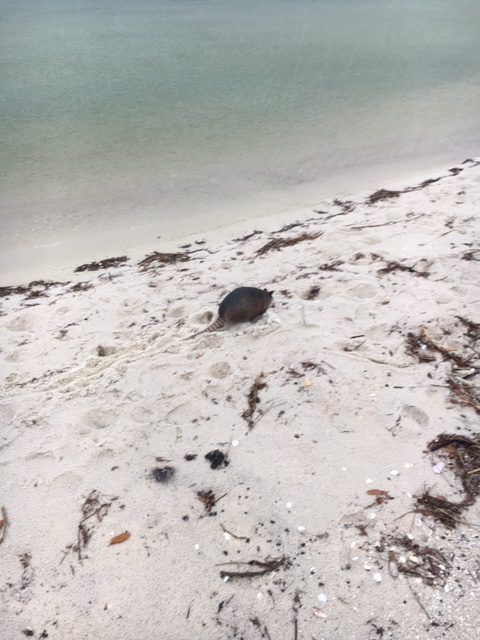
by Rick O'Connor | Aug 21, 2020
You are probably not going to see them… but they are there.
Mammals are fur covered warm blooded creatures. Beaches are hot, dry, sandy places. Just as in the deserts, it would make sense for island mammals to be nocturnal. We know of their existence by their tracks and their scat. Rabbit, raccoon, and armadillo tracks are quite common. Deer, coyote, and beach mice less so. All that said, some are seen at dawn and dusk and it is not unheard of to see them in the middle of the day – especially during the cooler months.
One question that may come up is – “how did they get to an isolated island?” Some scientists have a lot of fun trying to solve that mystery. Some island mammals, like otters, are very good swimmers and would have no problem. Many barrier islands begin as sand spits connected to the mainland – the mammals ventured out into new territory – set up camp – and either over time, or over night in a hurricane – the spit breaks off and the mammals are there. And let’s not forget we built bridges – they know how to use them. Coyotes have been seen walking across the Bob Sikes Bridge from Gulf Breeze.
Another question that comes up – “where are they in the middle of the day?” Most dig, or find, burrows and dens. Just a few inches below the surface it is very cool. Some will find thick hammocks in the maritime forest and “hunker down” for the day.
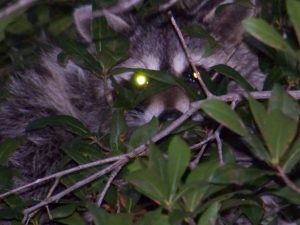
The sneaky raccoon is an intelligent creature and has learned to live with humans.
Photo: Molly O’Connor
Raccoons
The raccoon (Procyon lotor) is one of the more intelligent and fearless of the beach mammals. Their opportunistic behavior frequently brings them into contact with humans. They will scurry across your lawn at night looking for insects, cat food, garbage, whatever they can find to eat – and outdoor lights do not seem to bother them. There are even videos of them reaching into “dog doors” searching. On the island, their tracks are often found in the marsh areas – where they grab shellfish and are one of the few animals that wash their food before eating it. They usually like to settle into hollow trees during the day. But on the island, it is more likely burrows in the sand.
Their tracks might show the presence of a claw (always hard in soft sand – better chance in wet). The front foot is smaller than the back and they walk with an alternating pattern – usually the front and back foot are close to each other – unless they are running. The front foot is about 2.5”x2.5” – a little round, and the index from the pad to the tip is thinner. The hind foot is about 2.5” wide but closer to 4” long.
The scat is cigar shaped and about 3” long.
Read more:
https://myfwc.com/media/1666/livingwithraccoons.pdf.
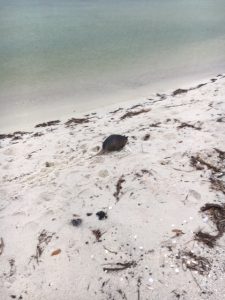
The bizarre looking armadillo enjoys a walk on the beach.
Photo: Rick O’Connor
Armadillo
Here is an interesting creature. It doesn’t even look like a mammal – not sure what it looks like. But mammals they are. If you find one that has been hit by a car you can see, amongst the armored plating, hairs spaced across the body – they are mammals. It is one that is sometimes seen roaming in the middle of the day. They plunge through the leaf litter and bushes of the maritime forest, making a lot of noise, while searching for insects and grubs and crushing them with their peg-like teeth. They are not from around here – rather from central America – and worked their way into the American southwest and southeast. They probably reached the island via the bridges. They are prolific produces – usually having quadruplets of the same sex. You once found them occasionally in the national seashore – but since Hurricane Ivan, you can find them almost anywhere. One bothersome fact of this animal – they are known to carry leprosy – which can be contacted by eating the animal, or handling it.
Their tracks are one of the most common on the beach. The front foot is about 1.8” long and 1.4” wide. You will see only four toes and claw marks may be seen. The two middle toes are longer. The hind foot has a similar pattern, but you will see five toes and they are about 2.2” long. Most tracks include the tail drag between the foot marks. These are quite common all over the island.
The scat is round-ish and not very long – about 2”.
Read more:
https://edis.ifas.ufl.edu/pdffiles/UW/UW45600.pdf
https://myfwc.com/wildlifehabitats/profiles/mammals/land/armadillo/
https://www.floridamuseum.ufl.edu/science/five-facts-nine-banded-armadillo/.

A coyote moving on Pensacola Beach near dawn.
Photo provided by Shelley Johnson.
Coyote
This is an animal that makes people nervous. They are one of the larger mammals on the beach, and they are carnivores. Attacks on pets and children are a concern for many. However, this is rarely the case. Studies show that they are actually very nervous around people and tend to stay at a distance. However, if fed cat food or available garbage, they will lose that fear and problems can occur. Like most island mammals, they are nocturnal, and diet studies have found the bulk of their meals are rodents – which is doing us a favor. But, like raccoons, they are intelligent and opportunistic. If they find an easy meal, like shorebird and turtle eggs – or the chicks and hatchlings – they will take them. It was once thought they were creatures of the American west and migrated into the eastern United States. Some scientists have found coyote remains in the eastern US that predate the ice age – so maybe they are just returning home. There are also reports of humans bringing them here for “fox hunts” – not realizing these were not fox. Either way, they are in all 67 counties of Florida, and on Pensacola Beach. They look similar to dogs – but will be thinner and their tails hang down between their legs when they run. One way to know if they are around is to listen when a siren is going – they tend to howl at these.
Their tracks are very similar to dogs and more people are bringing dogs onto the beach and into natural areas – hard to tell them apart. The pad at the rear of both the front and back paws of the coyote has three lobes, dogs have two on the front foot. In general, dog tracks are more round, coyotes typically are long and not as wide. Characteristic of dog family – the claw marks can be seen. Keep in mind that tracks are distorted in soft sand – best to look in wet sand.
The scat is also characteristic of wild canines – long and thin (like a hot dog) and tapered at each end (like a tamale). Coyote scat is usually 3-8” long and may have the characteristic claw scratching marks some dogs do.
Read more:
https://edis.ifas.ufl.edu/pdffiles/UW/UW44300.pdf.
https://myfwc.com/conservation/you-conserve/wildlife/coyotes/.
https://myfwc.com/wildlifehabitats/profiles/mammals/land/coyote/
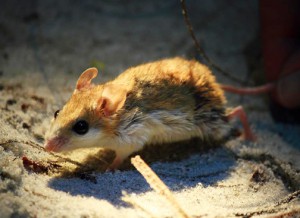
The Choctawhatchee Beach Mouse is one of four Florida Panhandle Species classified as endangered or threatened. Beach mice provide important ecological roles promoting the health of our coastal dunes and beaches. Photo provided by Jeff Tabbert
Beach Mouse
Beach mice are like the Loch Ness monster – everyone talks about them, but no one has seen one. Many locals have lived on this beach all of their lives and have never seen one – but they are there – and they are protected. The deal with protection is that these are isolated populations on each island. With no chance to mix genes, they have become “unique” and found no where else. There are four species in the state listed as endangered – including the nearby Perdido Key Beach Mouse and the Choctawhatchee Beach Mouse. It is believed the subspecies found on Pensacola Beach is the Santa Rosa Beach Mouse and is not listed as endangered – but is a species of concern (see list in link below). These little guys dig multiple burrows throughout the dune field but prefer those that are more open and have plenty of sea oats. They emerge at night feeding on a variety of seeds, fruits, and even insects – but sea oats are their favorite. It has been suggested they play an important role of dispersing these seeds. The introduction of new predators, and human development, have put these guys at high risk of extinction.
As you can imagine, the tracks are tiny. They are round in shape and show claw marks.
Read more:
https://edis.ifas.ufl.edu/pdffiles/UW/UW17300.pdf.
https://myfwc.com/media/1945/threatend-endangered-species.pdf.
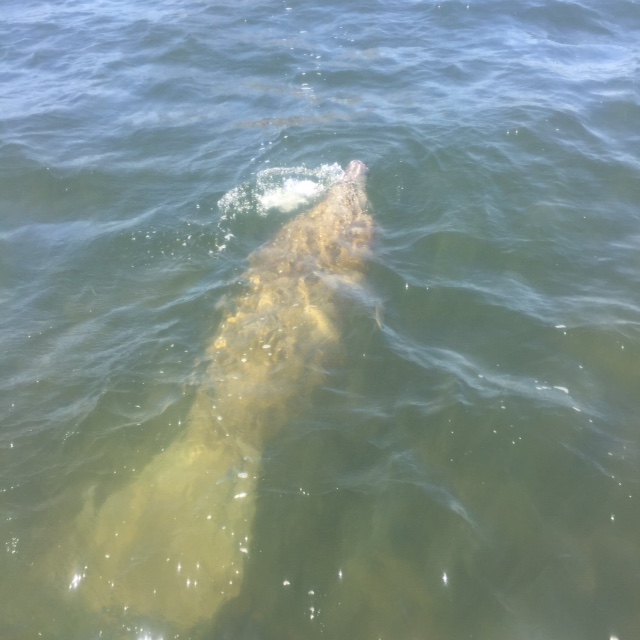
by Rick O'Connor | Aug 13, 2020
Mammals are historically land-based, or terrestrial, animals. They are quadrupeds (four legs) and run with a cursorial form of locomotion (backbone moving up and down) – some are the fastest land animals the planet has ever seen. But as fate would have it, some returned to the sea and occupied niches there. They are so well designed for a life in water that even look like fish. However, they differ in several ways:
1) Their tail extends horizontally instead of vertically and moves in an up and down motion instead of a side to side.
2) They of course lack scales, but they lack the characteristic hair of mammals as well. Though some hair may be found if you look close enough, they use blubber (layers of fat) to keep their bodies warm instead. Due to their warm blooded-ness, many do very well in cold parts of the ocean.
3) They also have mammalian lungs – not gills. Amazingly they exchange almost 90% of the air in their lungs with each breath (compared to about 20% for humans). With this huge load of oxygen, they remain underwater for long periods of time and dive to deep depths. The record would belong to the sperm whale who can dive to depths of 3000 feet for up to 90 minutes!
4) And of course, they give live birth nurturing the developing fetus with a placenta and feeding the developing young with milk from their mammary glands – this is not found in fish.
There are three orders of marine mammals: The Cetaceans (whales and dolphins), Pinnipeds (seals and sea lions), and Sirenians (manatees and dugongs). All three were once found in the Gulf of Mexico. Today there are only cetaceans and sirens, the lone pinniped (the Caribbean Monk Seal) is now believed to be extinct.
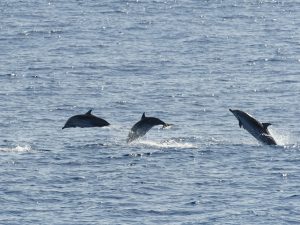
A group of small dolphin leap from the ocean.
Photo: NOAA
Dolphins
The Atlantic Bottlenose Dolphin (Tursiops truncatus) is the most common dolphin seen by visitors in our area. This lively, playful, and intelligent creature is the one most often seen at aquarium shows. Dolphins are whales, just small ones, and belong to a group known as “toothed whales”. They have numerous conical canine-type teeth used for grabbing fish and squid. Lacking molars, they cannot chew – so they must select prey they can either cut into smaller pieces, or swallow whole as is.
The toothed whales are known for their ability to detect prey using a form of SONAR called echolocation. Sound pulses are produced by flaps of skin within the blowhole (the nostrils of the dolphin) and exit the animal through a blob of fat in the head called the melon. Low frequency clicks can travel farther and find the targets, high frequency clicks have smaller range but can tell the dolphin what type of fish it is, and some whales can even produce high enough frequencies to literally “stun” their prey in the water – making it easier to grab. These “echo’s” or “clicks” are usually above (or below) our hearing range.
Dolphins are very social animals, traveling in large groups called pods. The pods are typically made of adult females and young, though there are one or two males. They communicate with each other using sound. The sounds are produced from the larynx in the blowhole area and are distinct for each pod. Outside dolphins are usually not allowed within the pod, so dolphins are not always the friendly creatures we perceive them to be – at least to each other.
When mom gives birth to a single calf (though very rare, twins have occurred) she rolls while swimming forward to expel the young – who must quickly surface for it’s first breath. The other females in the pod usually help with this. The baby suckles milk from hidden mammary glands which the mom exposes with the calf nudges her side. The calves stay with their moms for about two years learning the tricks of the trade before the cycle begins again.
These are truly amazing animals. Read more about dolphins at:
https://www.fisheries.noaa.gov/species/common-bottlenose-dolphin.
https://www.dolphincommunicationproject.org/index.php/the-latest-buzz/the-dolphin-pod/item/94419-how-does-echolocation-work.
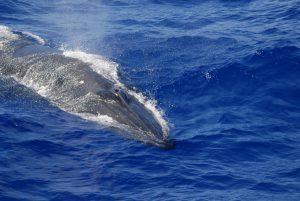
The large head and double blowhole of a Bryde’s whale.
Photo: NOAA
Whales
Though dolphins are whales, there are many others. The order Cetacea is broken into two suborders – the toothed whales (Odontoceti – which includes the dolphins) and the baleen whales (Mysteiceti). There are at least 20 species of whales and dolphins reported from the Gulf of Mexico – only one of those is a baleen whale, the Bryde’s Whale. Mammals as a group are known as heterodonts (meaning they have more than one type of tooth in their mouths). You, for example, have incisors, canines, pre-molars, and molars. Whales and dolphins break this rule by being homodonts. The toothed-whales and dolphins have conical canine teeth. Baleen whales have a fibrous hair-like material in their upper jaw that is stiff like the bristles of a toothbrush called baleen. The whale swallows seawater and then pushes it through the baleen trapping small shrimp and fish which they lick down their throats.
Whales are known for their long migrations – some of the longest in the animal kingdom. Their thick blubber and large size allow them to survive in polar waters – where much of their food is found. However, their babies are smaller (albeit 5-10 feet small) and they are not prepared for such cold waters. So, mom must migrate to tropical waters to give birth – fatten the baby up with some of the richest milk in the mammal group – and migrate back so she can feed herself. To navigate they use sound, the Earth’s magnetic field, and their eyes to do so. Whales can produce very low frequency sounds that can travel thousands of miles across the ocean echoing off objects that may be familiar to them. They also have magnetite in their retinas that allow them to pick up the Earth’s magnetic field, much the same as a compass does. And scientists also believe the act of spyhopping, where a whale will stop – turn vertical in the water – and extend their head above the surface – is in fact checking landmarks to aid them.
As with dolphins – these are amazing animals. Read more at:
https://aquatic.vetmed.ufl.edu/services/stranding-response/marine-animals-of-the-gulf-of-mexico/.
https://www.fisheries.noaa.gov/species/brydes-whale.
http://www.pbs.org/kqed/oceanadventures/episodes/whales/indepth-navigation.html.
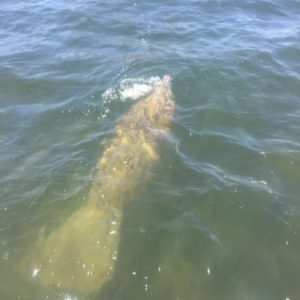
Manatee swimming in Big Lagoon near Pensacola.
Photo: Marsha Stanton
Manatees
“Mermaids”… at least that was what Christopher Columbus thought when he reached the new world. I guess they have that body shape… I guess. These are marine mammals but are not related to whales and dolphins. Instead, their closest living relatives are elephants. This is because mammals are divided into orders based on the type, and number, of teeth they have – and manatee teeth are nothing like dolphins. They have square shaped molars with ridges on the upper surface for grinding plant material – they are vegetarians. Most herbivores, like horses, have large incisors that can cut the grass and then move them back to their gnawing molars. Manatees lack these incisors. Instead they use their large lips, much the same as an elephant uses its trunk, to extend – and grab the grass, pulling it from the bottom of the bay and then gnawing with those big molars.
The differ from dolphins in other ways:
1) Their fluke (tail) is more round than forked – and they travel MUCH slower.
2) They lack a blow hole – but do still have nostrils. They are positioned closer to where ours are so they must extend part of their head out of the water in order to breath.
3) Though some whales lack dorsal fins – all manatees do.
4) They also do not tolerate polar waters very well. There was one species – the Stellar Sea Cow – that lived in Alaska, but this animal was MUCH larger than the tropical manatee – large size allows you to maintain a higher body temperature. It is now extinct – hunted out by fishermen as a food source while fishing. The animal was actually named after one of them – Captain Georg Stellar.
5) They are also not as social – manatees are usually loners except during breeding season and gathering in warm springs during the winter.
That said, they are migrators as well. They will venture out during the warm months to seagrass beds in the north – including Pensacola Beach – returning to the warm springs of central Florida, or the tropical waters of south Florida, in the winter. Navigation, in their case, is a bit easier – they are coastal – manatees do not travel out to sea as whales and dolphins do. They slide along the coastline, eating as they go, enjoying the sun, and avoiding boats. Locally we see them along the Gulf side, in the Intracoastal, and even up into the bays and bayous of Pensacola Bay as they move from Mobile Bay to and from central Florida.
WE DO HAVE A CITIZEN SCIENCE REPORTING PROGRAM FOR THIS ANIMAL.
If you see one contact Sea Grant Agent Rick O’Connor (roc1@ufl.edu ). We would like to know – exactly where you saw it, date you saw it, time you saw it, was it alone, and which direction was it traveling.
As with other marine mammals – manatees are amazing to see and can be the highlight of your visit. We ask that while boating, when you approach shore please slow speed and (if possible) have a spotter looking to make sure you do not hit one of these charismatic creatures.
Read more at:
https://www.fws.gov/refuge/Crystal_River/wildlife_and_habitat/Florida_Manatee.html.
https://www.savethemanatee.org/manatees/migration/.




















